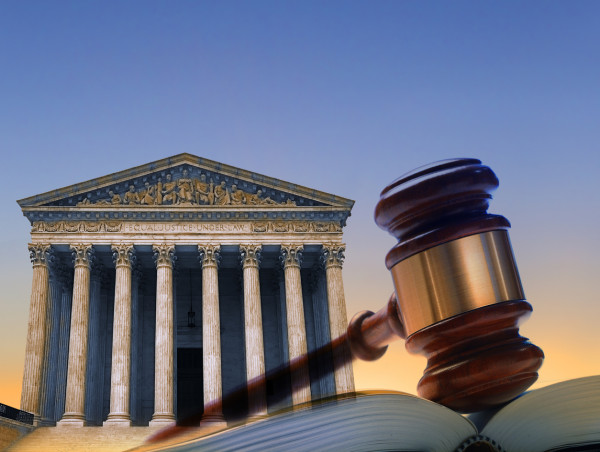The decision directly connects to Johnson & Johnson’s (J&J) attempts to resolve talc cancer claims in bankruptcy court, according to Chris Tisi, Attorney at the Levin Papantonio law firm who serves as a member of the Plaintiffs’ Steering Committee in the talc cancer multidistrict litigation (MDL 2738, In Re: Johnson & Johnson Talcum Powder Products Marketing, Sales Practices and Products Liability Litigation).
Tisi is also a committee representative of the Official Committee of Talc Claimants (TCC).
Tisi and other plaintiffs’ attorneys in the talc cancer MDL have consistently warned of the disastrous effect that a bankruptcy-protection green light would have on future cases of personal injury from corporate wrongdoings. Tisi said today’s Supreme Court decision allays some of these concerns.
“In our view, the Supreme Court has shut the door on Johnson & Johnson’s (J&J) egregious attempt to use bankruptcy as a shield from accountability,” Tisi said. “For decades, J&J, much like the Sacklers, engaged in corrupt and calculated misconduct that killed thousands, thinking their half-trillion-dollar empire could hide behind the apron strings of a shell corporation.
“This decision makes it clear: The bankruptcy court is not a refuge for a company of this magnitude to escape the consequences of its actions.
“Had the Court ruled the other way, business schools everywhere would be teaching MBA students how to help Wall Street prosper off of the deaths of the people they injure,” Tisi remarked.
Quotes From the Supreme Court Opinion
The following quotes from the Harrington v. Purdue Pharma decision shed light on how the U.S. Supreme Court views bankruptcy courts’ role in resolving claims:
* “So, yes, bankruptcy law may serve to address some collective action problems, but no one (save perhaps the dissent) thinks it provides a bankruptcy court with a roving commission to resolve all such problems that happen its way, blind to the role other mechanisms (legislation, class actions, multi-district litigation, consensual settlements, among others) play in addressing them.” p. 13
* “To win a discharge, again as we have seen, the code generally requires the debtor to come forward with virtually all its assets. §§541(a)(1), 548. Nor is the discharge a debtor receives unbounded. It does not reach claims based on “fraud” or those alleging “willful and malicious injury.” §§523(a)(2), (4), (6). And it cannot “affect any right to trial by jury” a creditor may have “with regard to a personal injury or wrongful death tort claim.” 28 U. S. C. §1411(a). The plan proponents and the dissent’s reading of §1123(b)(6) transgresses all these limits too. The Sacklers have not agreed to place anything approaching their full assets on the table for opioid victims. Yet they seek a judicial order that would extinguish virtually all claims against them for fraud, willful injury, and even wrongful death, all without the consent of those who have brought and seek to bring such claims. In each of these ways, the Sacklers seek to pay less than the code ordinarily requires and receive more than it normally permits.” P. 15
* “[T]he Trustee urges us to consider the ramifications of this case for others. Nonconsensual third-party releases, he observes, allow tortfeasors to win immunity from the claims of their victims, including for claims (like wrongful death and fraud) they could not discharge in bankruptcy, and do so without placing anything approaching all of their assets on the table. Endorsing that maneuver, the Trustee says, would provide a “roadmap for corporations and wealthy individuals to misuse the bankruptcy system” in future cases “to avoid mass-tort liability.” P. 18
* “But, in the end, we are the wrong audience for them. As the people’s elected representatives, Members of Congress enjoy the power, consistent with the Constitution, to make policy judgments about the proper scope of a bankruptcy discharge. Someday, Congress may choose to add to the bankruptcy code special rules for opioid-related bankruptcies as it has for asbestos-related cases. Or it may choose not to do so. Either way, if a policy decision like that is to be made, it is for Congress to make.” P. 19
It’s Good News for Plaintiffs’ Firms That Oppose J&J Bankruptcy
Last week, more than 60 of the nation’s most prominent law firms, known for their dedicated and successful representation of individuals harmed by dangerous products, announced their unified opposition to Johnson & Johnson’s plan to seek a prepackaged bankruptcy to address claims from ovarian cancer victims.
For the bankruptcy plan to succeed, J&J must show that 75% of the talc claimants have voted to participate in the plan.
According to plaintiffs’ attorneys, J&J is scrambling to meet these numbers by swabbing the system with illegitimate claims. “People who have esophageal cancer and say they were in the vicinity of J&J’s baby powder for a month are being told, ‘Take a ballot, and you can get compensation through the bankruptcy court,'” said Attorney Mike Papantonio, of the Levin Papantonio law firm. “People are being lied to, and it’s hurting legitimate cancer claimants across the board.”
J&J, with a market value exceeding $350 billion, has already had two previous bankruptcy filings denied by federal courts in New Jersey, where the company is headquartered.
Sara Stephens
Levin Papantonio
+1 281-744-6560
email us here
![]()






